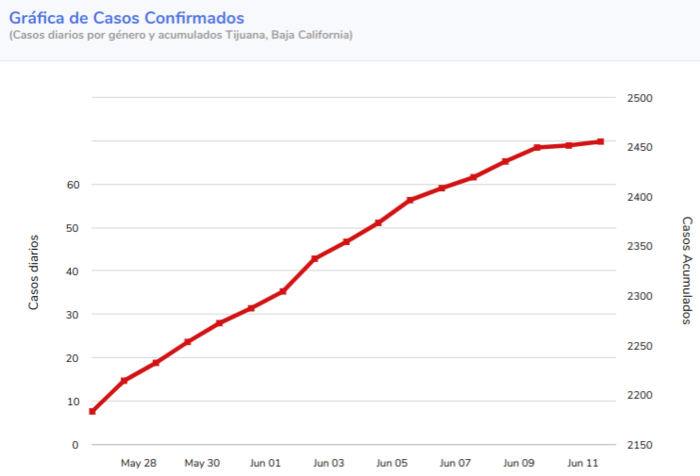Coronavirus in Tijuana, Baja California
Follow in detail the most important information of today about the arrival of the Covid-19 coronavirus in Tijuana, Baja California.

As of today, Tijuana coronavirus cases total 2,421 and 111 deaths, according to information provided by Health Secretariat. And while the signal in Baja California is still red, already tending to orange, at least that's what health authorities estimate, in Tijuana, the opening is almost abrupt.
The red light is supposed to imply only essential activities, at least at the federal level is that they have reiterated it. Cases continue to be reported in more than 100 a day in the state, as well as more than 30 deaths a day as well.
This weekend, restaurants, public parks, and sports units were already operating in Tijuana, but not only that, but also department stores, bars, casinos, and table dancers, and other types of businesses. The traffic of vehicles and people has already intensified compared to days ago, but every month more people can be seen on the streets wearing masks.
The businesses that obtained permission to operate need to comply with certain sanitary measures, the distance between clients and not to fill the premises, some even have a sanitary tunnel. Thus, in the venues, one could see the waiters with masks and gloves and the places occupied by the customers distant from each other.
Given this reopening, it is now up to those responsible for the businesses to look after employees and customers and to the citizens to decide whether or not to go out and what kind of activities or businesses are essential to them.

"Tijuana, One of the Most Infected Places in the World": Trump
The U.S. president indicated that he will soon visit the California border area to supervise the construction of the fence between Mexico and the United States.
"Very few people are crossing our border," Trump said in an interview, noting the proximity between the cities of Tijuana and San Diego, California. He also said that the people of that state are very happy to have him as president.
The U.S. president's comments have been interpreted as a preview of the possibility that the White House will issue an alert for travel from Mexico, which he might consider a threat from the new wave of infections in his country.
A media blurb shared that this measure has been discussed by the coronavirus working group in the White House crisis room. There, it would have been suggested that the Centers for Disease Control and Prevention (CDC) send teams to Spanish-speaking communities in the states of Arizona, California, Texas, and North Carolina, where there are increases in COVID-19 infections, to try to track the origin of the new outbreaks and contain them.
It should be noted that Mexican health authorities have presented data that belie Donald Trump's claims. According to Mexico's Undersecretary of Prevention and Health Promotion, Hugo Lopez-Gatell, the incidence of infections in Tijuana has decreased in recent weeks.
"In Tijuana, we have positive news, since [the COVID-19 epidemic] reached a peak on the date that had been contemplated and subsequently there has been a continuous decrease in the number of new cases registered," he said on June 17.
Why Baja California ranks 2nd in the country for COVID-19 deaths?
Unlike Mexico City and the State of Mexico, the high number of infections in Baja California does not respond to a large number of people, since the state is home to about 3.6 million Mexicans, ranked 15th by the population.
The reason for the high number of infections in that state is its proximity to the southern border of the United States and all the activity it has with that country, which today occupies the first place worldwide of positive cases and deaths caused by Covid-19.
The flow of commerce and people has also placed that entity as the third with the highest number of infections.
There are at least five reasons for the high number of infections and deaths of coronavirus:
Migration
Labor mobility between Mexico and the United States
The entry of American tourists into Mexican territory to acquire supplies
The arrival of Mexicans who come to visit their relatives in Mexico
The manufacturing industry that, despite the deaths, has not stopped.
There is still an influx of people at the border, although the number has dropped. Before the pandemic, up to 150,000 people crossed the border every day; now only about 30,000 do.
Between 10,000 and 12,000 people pass through Tijuana alone every day to work in the United States and return, and to that number must be added the 4,000 migrants who are being expelled monthly from the U.S.




